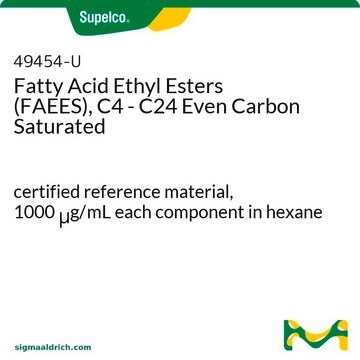A9135
Ethyl arachidonate
≥98.5% (GC), liquid
Synonym(s):
5,8,11,14-Eicosatetraenoic acid ethyl ester, Arachidonic acid ethyl ester
About This Item
Recommended Products
biological source
fungus
Assay
≥98.5% (GC)
form
liquid
functional group
ester
lipid type
omega FAs
shipped in
ambient
storage temp.
−20°C
SMILES string
CCCCC\C=C/C\C=C/C\C=C/C\C=C/CCCC(=O)OCC
InChI
1S/C22H36O2/c1-3-5-6-7-8-9-10-11-12-13-14-15-16-17-18-19-20-21-22(23)24-4-2/h8-9,11-12,14-15,17-18H,3-7,10,13,16,19-21H2,1-2H3/b9-8-,12-11-,15-14-,18-17-
InChI key
SNXPWYFWAZVIAU-GKFVBPDJSA-N
Looking for similar products? Visit Product Comparison Guide
Biochem/physiol Actions
Packaging
Storage Class Code
10 - Combustible liquids
WGK
WGK 3
Flash Point(F)
Not applicable
Flash Point(C)
Not applicable
Personal Protective Equipment
Certificates of Analysis (COA)
Search for Certificates of Analysis (COA) by entering the products Lot/Batch Number. Lot and Batch Numbers can be found on a product’s label following the words ‘Lot’ or ‘Batch’.
Already Own This Product?
Find documentation for the products that you have recently purchased in the Document Library.
Customers Also Viewed
Our team of scientists has experience in all areas of research including Life Science, Material Science, Chemical Synthesis, Chromatography, Analytical and many others.
Contact Technical Service













